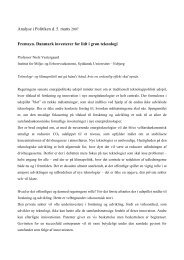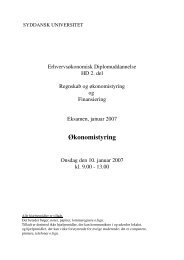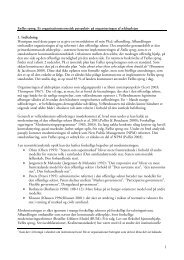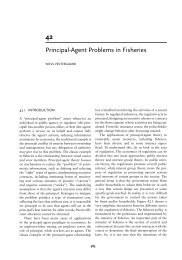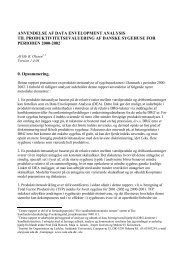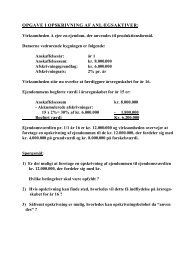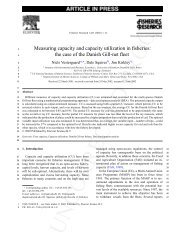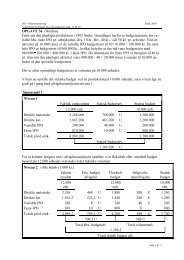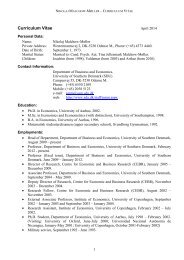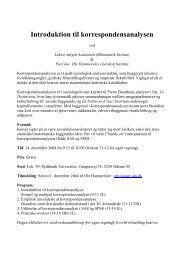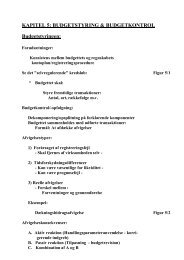Development of Parties and Party Systems in ... - lah@sam.sdu.dk
Development of Parties and Party Systems in ... - lah@sam.sdu.dk
Development of Parties and Party Systems in ... - lah@sam.sdu.dk
- No tags were found...
You also want an ePaper? Increase the reach of your titles
YUMPU automatically turns print PDFs into web optimized ePapers that Google loves.
expected, much due to the many splits <strong>and</strong> “wars <strong>in</strong> the top” on the Polish Right. The experiencefrom be<strong>in</strong>g activists <strong>in</strong> opposition to the old system, phrases like “civil society aga<strong>in</strong>st the state” <strong>and</strong>the image <strong>of</strong> a united society fight<strong>in</strong>g aga<strong>in</strong>st the authorities <strong>and</strong> their imperial supporters, i.e. theSoviet Union, were no longer a decisive factor after the fight aga<strong>in</strong>st the old system had been won.Furthermore, transformation <strong>and</strong> democratisation <strong>in</strong> Pol<strong>and</strong> has been <strong>in</strong>fluenced by agents <strong>and</strong>structures external to the Polish state constitut<strong>in</strong>g important structural causes for the collapse <strong>of</strong> theold system <strong>and</strong> the formation <strong>of</strong> the new. The <strong>in</strong>fluence <strong>of</strong> external agencies such as <strong>in</strong>ternationalf<strong>in</strong>ancial organisations <strong>and</strong> human right movements was mediated through domestic social <strong>and</strong>political <strong>in</strong>stitutions 39 . As far as the first years are concerned we mostly had to do with a political”muddl<strong>in</strong>g through”. The “party’ist” type <strong>of</strong> democracy has been less pronounced <strong>in</strong> Pol<strong>and</strong> than <strong>in</strong>the Czech Republic <strong>and</strong> Hungary because <strong>of</strong> low party <strong>in</strong>stitutionalization, fragile multiparty system<strong>and</strong> party fragmentation. <strong>Parties</strong> <strong>in</strong> all CEEC’s tended to be cadre configurations, not massorganisations. Under those circumstances non-democratically elected <strong>in</strong>stitutions like trade unions<strong>and</strong> church <strong>and</strong> national banks may obta<strong>in</strong> a stronger political position, thereby limit<strong>in</strong>g theautonomy <strong>and</strong> the consolidation <strong>in</strong> the political sphere, <strong>and</strong> the significance <strong>of</strong> political parties <strong>and</strong>party systems.From the outset the polarisation <strong>of</strong> Polish politics followed four l<strong>in</strong>es:• between Solidarity <strong>and</strong> post-communists, i.e. on the structural level• <strong>in</strong>side the Solidarity movement (“the wars <strong>in</strong> the top”), i.e. on <strong>in</strong>stitutional level• for or aga<strong>in</strong>st the president (Walesa), i.e. on actor level• for or aga<strong>in</strong>st the Balcerowicz plan I, i.e. the economic chock-therapy, i.e. on policy-levelThe first type <strong>of</strong> polarisation was dom<strong>in</strong>ant just at the time <strong>of</strong> the “break through” <strong>in</strong> 1989 <strong>and</strong> hasnever been de-freezed. The dom<strong>in</strong>ant model underly<strong>in</strong>g Solidarity, that <strong>of</strong> civil society aga<strong>in</strong>sttotalitarianism, underm<strong>in</strong>ed Solidaritys own struggle as Solidarity was not able to go beyond theculture <strong>and</strong> the history go<strong>in</strong>g back to 1980-81 <strong>and</strong> identify new conflicts <strong>and</strong> alternative futuresunder post-communism. Later <strong>in</strong> the 1990s, i.e. after the formation <strong>of</strong> the formation <strong>of</strong> the SLD-PSL government <strong>in</strong> 1993, a new political divide, “for <strong>and</strong> aga<strong>in</strong>st the president” (Walesa) ga<strong>in</strong>edmomentum. The “cohabitation” between AWS led government <strong>and</strong> post-communist president hasbeen difficult <strong>and</strong> never found the optimal form. However, the later president Aleks<strong>and</strong>erKwasniewski did not make the same serious mistakes as Lech Walesa. In short, structural factors,i.e. the legacy <strong>of</strong> the past, soon obta<strong>in</strong>ed a dist<strong>in</strong>ct subjective side. To better underst<strong>and</strong> the mean<strong>in</strong>g<strong>of</strong> Solidarity, we also have to <strong>in</strong>clude the <strong>in</strong>ternal constitution <strong>of</strong> the movement itself, i.e.<strong>in</strong>stitutional factor.At the 1991 election an extreme multiparty system emerged with no less than 27 different politicalgroups represented <strong>in</strong> parliament. The non-party system characteristics were strik<strong>in</strong>g until the 1993election. Adversary politics, governmental overload, overparliamentarization, party’ism, party splits39 F. Steves, “Pol<strong>and</strong> <strong>and</strong> the <strong>in</strong>ternational system: external <strong>in</strong>fluences on democratic consolidation”, Communist <strong>and</strong>Post-Communist Studies 34 (2001):339-352.44



